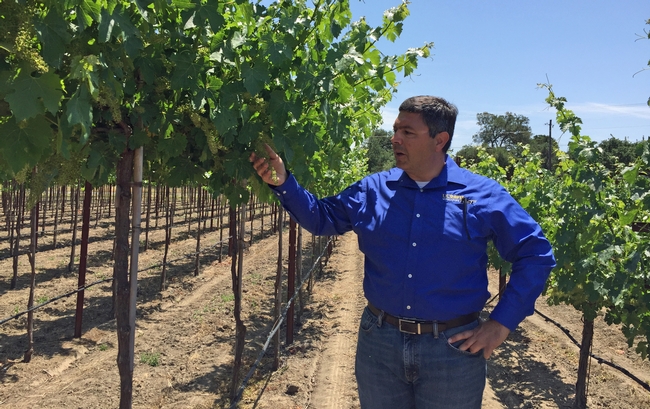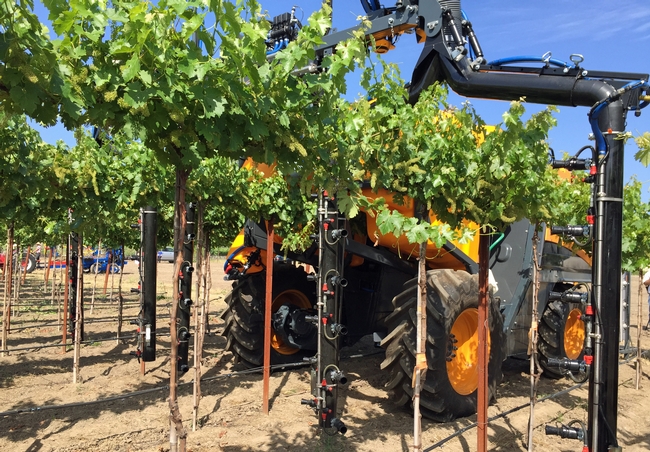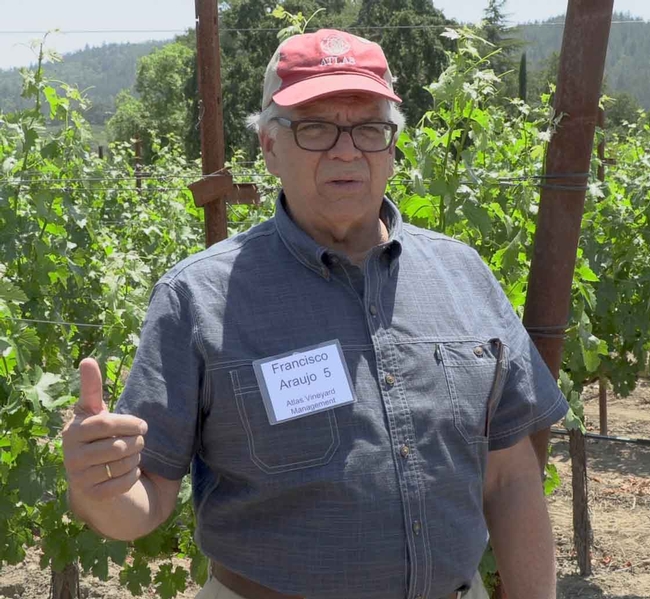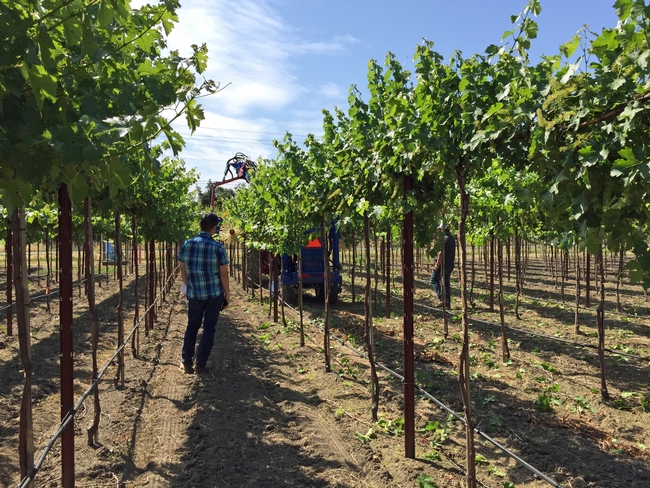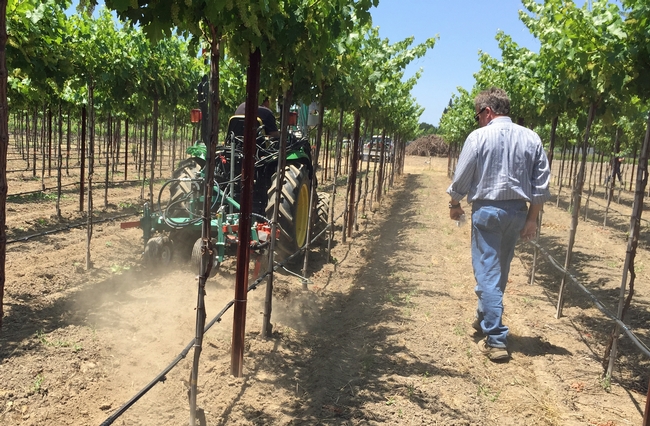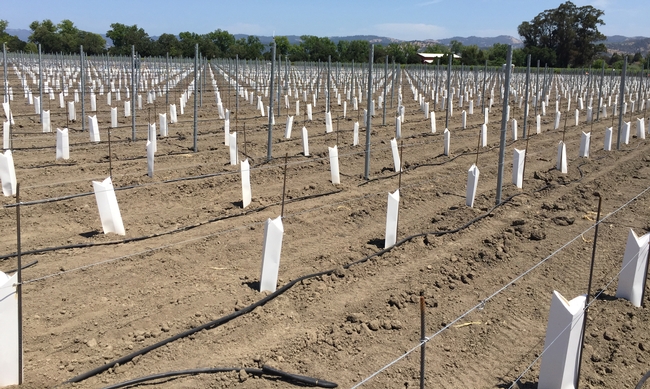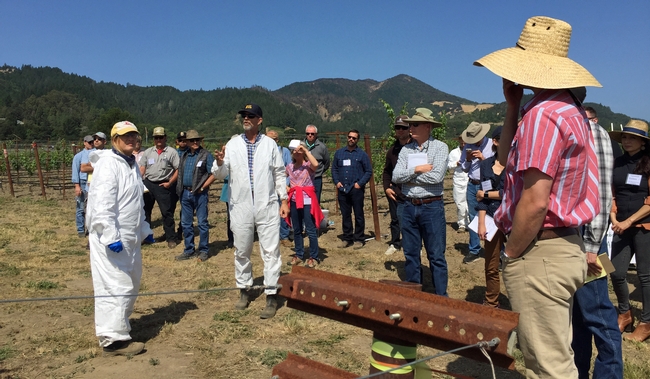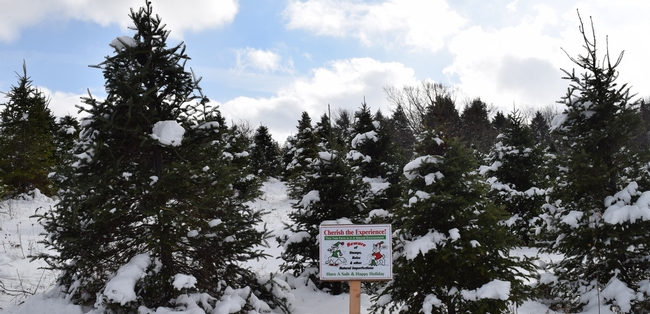
Posts Tagged: Lynn Wunderlich
Growers get labor-saving ideas at UC Grape Day
Will machines replace the romance of the hand-cultivated wine grape vineyard? A “touchless” vineyard was among the latest research on labor shortages, weeds and pest management by UC Cooperative Extension scientists discussed at Grape Day at the UC Davis Oakville Station, located in the epicenter of California wine country, on June 6.
About 200 wine grape growers, vineyard consultants and other industry people attended to learn about the latest UC Cooperative Extension research. Vineyard managers from boutique wineries such as Fork in the Road to Pine Ridge Vineyards to the Fortune 500 wine company Constellation Brands gathered at the research station's experimental vineyard. Several vineyard equipment representatives brought their machines to the field to demonstrate their weeding, pruning and canopy management capabilities.
Addressing labor shortages
To help growers attract and retain farm workers, Monica Cooper, UC Cooperative Extension advisor for Napa County and her research assistant, Malcolm Hobbs, are conducting a survey of agricultural workers to determine the factors that affect job satisfaction. They found the number of female workers in Napa County has increased rapidly since 2013. “Women may be moving into the labor pool to fill vacancies caused by the decline in the number of male workers migrating to the U.S. for agricultural work,” Cooper said.
They plan to provide participating companies with custom recommendations for recruiting and retaining workers.
“We will also be generating a generic summary that will be widely shared with participants and non-participants at the close of the study. For now, we cannot make any general conclusions or recommendations because data collection is ongoing,” Cooper said. “We are aiming to distribute our final report this winter, so stay tuned.”
To help growers reduce their need for hand labor, UC Cooperative Extension viticulture specialist Kaan Kurtural designed a “touchless” demonstration vineyard that is mechanically managed. The mechanized vineyard is one of six trellis systems he is studying for water use, nitrogen use efficiency, yield and fruit quality of the wine grapes.
“We're always looking for ways to improve yield, quality and to reduce cost,” said Francisco Araujo, director of viticulture for Atlas Vineyard Management. “In light of the labor shortage we're facing right now, Kaan is exploring new production systems that include new trellises, mechanization, different types of mechanization from pruning to shoot thinning and trunk suckering. He's obtaining information about how these new trellis systems that he is investigating are going to play with yield and quality.”
The touchless vineyard experiment started out as a demonstration at first, but with grower interest, it turned into a full-blown research project.
“It started as way of saving labor costs, but when we started looking at the physiological aspects of how these plants grow, we saw the benefits from the quality point of view in addition to the labor savings,” said Kurtural, who is based in the Department of Viticulture and Enology at UC Davis.
A traditional vineyard in the Napa area is about a meter or 36 inches above the vineyard floor with vertical shoots held up with wires, which are moved by hand.
Saves water
“We said, ‘Why don't we turn the system upside down?' Grow a tall trunk then put the bilateral cordon about 62 inches above the vineyard floor, that way we can push the rows a lot closer,” said Kurtural, who oversees the 40-acre Oakville experimental vineyard. The leaves grow down to generate the same leaf area as a traditional vineyard, but the leaves in the mechanized vineyard use water more efficiently so the no-touch vineyard requires less water compared to traditional vineyard systems.
“This is a dense system, this is 1.5 meters by 2 meters, roughly 1,340 plants per acre – we're getting by here on a third to quarter acre foot of water,” Kurtural said.
“It costs us roughly about a dollar in labor operation costs to manage each plant in a traditionally farmed vineyard of roughly about 1,300 plants per acre on the North Coast now,” Kurtural said. “The no-touch plants are costing us about 7 cents in labor operations costs.”
“The biggest expense is pruning, after that we go through what they call trunk suckering, which is also done mechanically here, and after that they will do shoot removal to open up the canopy. That's also done mechanically. After that, if there's need, they will do leaf removal, that's also done mechanically. And one last resort, if there's too much crop here, they will shake off excess berries with a harvester.”
The conventional system yields up to 5 to 6 tons per acre whereas the mechanized vineyard yields 7 to 8 tons per acre.
“These clusters set far fewer berries than a traditionally managed vineyard, but the berry size is also very small, which is what the winemakers like,” he said.
During harvest, grapes picked by machine are sorted on board the harvester so they go into the winery in uniform sizes, whereas hand-harvested grapes have to be sorted on a tray before they are put into the press tank.
“We made wines from these last year and compared to our traditionally farmed vineyards. Until we tell people what it is, they cannot distinguish the quality of the fruit or the wine.”
Weed and pest management
John Roncoroni, UCCE weed science farm advisor in Napa County, discussed options for weed control among young grape vines.
In the past, many vineyards were fumigated before planting for disease control, but it also provided weed control for young vines.
“With the loss of most fumigants for use in vineyards, hand-weeding was often used to accomplish this task,” Roncoroni said. “Increased costs and decreased labor force have made hand weeding impractical. Mechanical cultivation, at this point, is too imprecise – either leaving weeds close to young vines or causing damage by being too close.”
Covers on young vines allow the use of many post-emergence herbicides to control weeds, but Roncoroni cautioned that application of post-emergence herbicides on vines that aren't protected by mature bark may damage or even kill the vine.
“Herbicide use on vines less than 3 years old is a risky endeavor,” Roncoroni said. “Follow all label requirements, paying special attention to soil and irrigation recommendations.”
Lynn Wunderlich, UC Cooperative Extension advisor for the Central Sierra, and Franz Niederholzer, UC Cooperative Extension advisor for Colusa, Sutter and Yuba counties, demonstrated how to calibrate sprayers and to get uniform coverage when spraying fungicides.
In 2016, UC Davis researchers identified the three-cornered alfalfa hopper, Spissistilus festinus, as a vector of grapevine red blotch virus. Cindy Preto, a Ph.D candidate in the UC Davis Department of Entomology who is assisting UC scientists studying the three-cornered alfalfa hopper's biology and host plants, provided an update on their research.
Araujo, the viticulture consultant, said he and his colleagues value the university's research. “Napa Valley is a place where quality is paramount yet more and more we have labor shortage, we have inflation, production costs are going up,” he said. “Finding a way to get maximum quality along with yield levels that will pay for the increasing costs of production is the only way we'll be sustainable now and in the future.”
March news clips
Unprecedented Study Discovers what Urban Coyotes Really Eat
(Care2) Laura Goldman, March 30
Hiking boots, avocados, candy wrappers and fast-food containers. These aren't a few of my favorite things, but they are some of the items found inside the stomachs of dead urban coyotes in Los Angeles and Orange counties.
…Since the study began over a year ago, the researchers, led by Dr. Niamh Quinn, the human-wildlife interactions advisor for the University of California Cooperative Extension, have discovered that cats make up only about eight percent of a coyote's diet.
https://www.care2.com/causes/unprecedented-study-discovers-what-urban-coyotes-really-eat.html
Red blotch grape virus confirmed in Calaveras
(Calaveras Enterprise) Jason Cowan, March 29
Red blotch virus, a DNA infection that decreases a grape's sugar levels on the vine, has been confirmed in Calaveras County, officials said last week.
After confirmed cases of the virus were located recently in El Dorado and Amador county vineyards, University of California Cooperative Extension Farm Adviser Lynn Wunderlich saw what she thought were symptoms of the virus in Calaveras and recommended farmers test for red blotch.
The results came back positive.
http://www.calaverasenterprise.com/news/article_4ebae972-33aa-11e8-ab5c-cb61df3e8deb.html
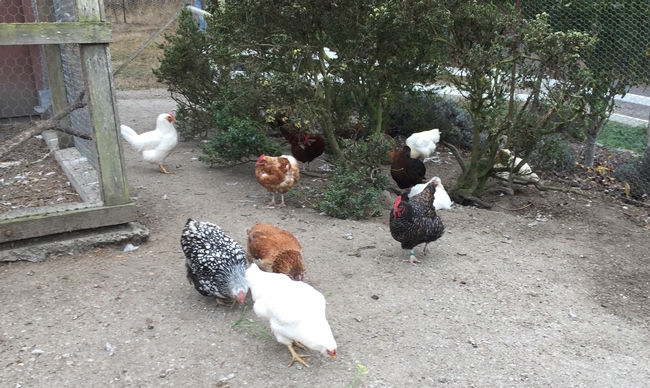
(Daily Democrat) ANR News release
Californians who raise poultry outdoors are invited to get their eggs tested for contaminants.
To find out if harmful substances on the ground that are eaten by hens get passed along in the eggs they lay, Maurice Pitesky, UC Cooperative Extension poultry specialist at the UC Davis School of Veterinary Medicine, is providing free egg testing.
“We're trying to understand the connection between the environment that backyard poultry are raised in and the eggs they are producing,” Pitesky said.
http://www.dailydemocrat.com/article/NI/20180329/FEATURES/180329815
Here's what trade tariffs could mean in Merced County, where nuts are big business
(Merced Sun-Star) Thaddeus Miller, March 28
China has threatened retaliatory tariffs on a select group of exports from the U.S. following President Donald Trump's plan to impose tariffs on steel and aluminum imports.
China's tariffs would first hit U.S. products such as avocados and nuts, with 15 percent duties. Beijing, if officials deemed it worthwhile, could also place 25 percent tariffs on American-made goods such as pork and aluminum.
…"It doesn't really matter which one it is, whether it's alfalfa, almonds or wherever it may go," said David Doll, a farm adviser with the Merced County UC Cooperative Extension. "They're as much political as they are anything else."
Nuts are big business in Merced County, where almonds are the second largest commodity at $578.5 million, according to the 2016 Merced County Crop Report, the most recent available. Almonds, pecans and pistachios bring in tens of millions of dollars more.
Out of every dollar made on a farm in the Central San Joaquin Valley, half pays for salaries and 40 cents goes to pay for supplies, Doll said, citing UC cooperative studies.
"Farms are businesses, and if they aren't profitable they're not going to stay in business," Doll said.
http://www.mercedsunstar.com/news/business/agriculture/article207155554.html
A film you may want your favorite doctor, trainer, chef and lawmaker to see
(Farm Week Now) Mike Orso, March 28
In the documentary “Food Evolution,” scientist Alison Van Eenennaam captures a smartphone selfie image of her with Bill Nye, the “Science Guy,” following a spirited forum in New York City on genetically modified organisms or GMOs. That was three years ago. Now, Van Eenennaam has young people coming up to her asking for selfies.
“If we can engage this next generation with critical thinking skills and trying to get to the bottom of what actually is true, I think we will have accomplished our job,” said Van Eenennaam, a University of California-Davis Extension specialist and one of several scientists featured in the film.
http://farmweeknow.com/story-film-may-want-favorite-doctor-trainer-chef-lawmaker-1-173628
Scientists say regulation stifles many new biotech traits
(Agri-Pulse) Jim Weber, March 28
Federal regulation of agricultural biotechnology needs to be based on risk and not on process, a wide range of scientists and food industry executives agreed at the Agri-PulseAg and Food Policy Summit. Coincidentally, a similar message was delivered a day later by a Council on Agricultural Science and Technology (CAST) task force.
“Scientists have been screaming that for 30 years,” said Alison Van Eenennaam, a cooperative extension specialist in animal genomics and biotechnology at the University of California-Davis. “That's where regulation should be.”
…Although the USDA, universities and small businesses have developed dozens of GE crops – with improved traits ranging from healthier and less allergenic to safer and more environmentally sustainable – and carried many through safety and pre-market testing, almost all have been denied commercial release mainly because of U.S. regulatory obstacles,” according to the CAST task force, led by Alan McHughen, who chairs the Department of Botany and Plant Sciences at California-Riverside.
https://www.agri-pulse.com/articles/10764-scientists-say-regulation-stifles-many-new-biotech-traits
If China Strikes Back On Tariffs, California Tree Nut Exports Could Take A Hit
(CapRadio) Julia Mitric, March 27
California agriculture could find itself caught in the middle of the U.S. — China trade dispute.
After President Trump ordered a 25 percent tariff on imported steel and a 10 percent tariff on imported aluminum last week, China hit back, announcing it may impose a 15 percent tariff on agricultural exports from the U.S.
The U.S. faces competitors for every agricultural product it exports. California wines, for example, compete with wines from New Zealand and Chile. If China hits the U.S. with a 15 percent tariff on wine, that's a problem, explains Dan Sumner, Director of the University of California Agricultural Issues Center.
"We may think California wine is special, but not everybody does,” Sumner said. "And if it's 15 percent more expensive than it used to be because of the tariff, there'll be a substantial reduction in how much gets sold in China."
State senator to honor UC 4-H program
(Morning Ag Clips)
California State Senator Ben Hueso will honor California and Baja California 4-H with a resolution in the State Senate at 2 p.m. April 2 to recognize the cross-border team that established a 4-H Club in Mexicali, Baja Mexico, in January 2017.
Last year, UC ANR Vice President Glenda Humiston signed a memorandum of understanding with the Baja California Secretary of Agriculture Development, Manuel Vallodolid Seamanduras, to offer UC's 4-H expertise to youth south of the border. The agreement increases the academic, scientific, technological and cultural cooperation that are part of UC President Janet Napolitano's Mexico Initiative.
https://www.morningagclips.com/state-senator-to-honor-uc-4-h-program/
Building an IPM Program to Fight Fruit Flies
(Growing Produce) David Eddy, March 26
When faced with spotted wing drosophila (SWD), it's critical for growers to keep in mind this is almost certainly unlike any pest they have dealt with before. That's because it's one of two species — out of a potential 1,500-plus — that feeds on healthy, not rotting, fruit.
That's certainly not the end of growers' difficulties with SWD, says Jhalendra Rijal, University of California Cooperative Extension Area IPM Advisor, Northern San Joaquin Valley. It's tricky because vinegar flies — the tiny flies often found circling above fruit bowls on kitchen tables — are so ubiquitous. Even the oh-so-common name, “fruit flies,” indicates the pests' omnipresence.
http://www.growingproduce.com/fruits/building-ipm-program-fight-fruit-flies/
Stallion Springs 4-H Swine Group visits local swine breeder
(Tehachapi News) Olivia Loyd, March 24
Tim Sturm, owner and operator of California Swine Services, farrowed approximately 600 piglets this year which will be shown all over California by 4-H and FFA members who take them to fairs and jackpot shows.
Sturm, who has a passion for teaching today's youth about raising swine, allowed the members of the Stallion Springs 4-H swine group to come to his facility on March 17 to learn to process one-day-old piglets. The kids learned to ear notch, dock tails, administer shots and clip needle teeth. Members learned why these processes are necessary, how to do them cleanly and correctly, and last were actually able take part in the process. They also learned valuable information about pig breeding and husbandry.
World Water Day
(KCAA) Water Zone, March 22
For World Water Day, Glenda Humiston discusses UC water research and what UC is doing to help ensure farmers and other Californians and the environment get the water they need. She also explains the Farm Bill. Humiston is introduced around the 30 min mark.
http://podcasts.kcaastreaming.com/water/ http://youtu.be/hN5pxvVI42A?a
Small Farms Must Include Marketing
(Cal Ag Today) Jessica Theisman, March 22
Mark Gaskell is with the University of California cooperative extension as a small farm and Specialty Crop Advisor for San Luis Obispo County. Gaskell recently told California Ag Today about his work with growers and small farms in the county since 1995.
“Part of my job has to do with applied research and educational programs, and this case related to keeping small farms viable and successful,” Gaskell said. “These activities include troubleshooting problems, helping growers develop new crops and develop new market opportunities that make them more competitive.”
https://californiaagtoday.com/small-farms-must-include-marketing/
How Biocontrols Fit into a Traditional Pest Control Program
(Growing Produce) Carol Miller, March 21
One of the great strengths of using biocontrols is that it allows growers to use traditional chemistries less often, says Surendra Dara, Strawberry and Vegetable Crop Advisor with the University of California Cooperative Extension. Dara was speaking to a packed room at the Biocontrols USA West conference in Carlsbad, CA, hosted by Meister Media Worldwide, the parent company of American Vegetable Grower.
http://www.growingproduce.com/vegetables/biocontrols-fit-traditional-pest-control-program/
Has the California dairy industry gone sour?
(Agri-Pulse) Tyler Ash, March 21 (Subscription only)
Rumors are circulating that a stampede of California dairy producers is heading toward greener pastures in other states. But why?
Experts in the nation's No. 1 milk-producing state have been ruminating on this dilemma for over a decade now, and it seems to stem from the same problems that are plaguing farmers all over America. Typical of the ag industry in general, mom-and-pop farms are going by the wayside and more large-scale farms are increasing production. So, the production seems to truck along but the number of players in that production does not.
“I remember being a kid, driving up I-5 and there were dairies all over the darn place,” said Jeff Stackhouse, livestock adviser for the University of California Cooperative Extension in Humboldt and Del Norte counties. “Now there's one.”
Statistics from the California Department of Food and Agriculture back him up. According to the agency, the state had 1,563 dairies in 2012 and four years later the number was 1,392, an 11 percent decline. The drop was 4 percent from 2015.
...Frank Mitloehner, professor of Animal Science at UC-Davis and a UC Cooperative Extension specialist, said California has lost approximately one fourth of its dairies over the last 15 years. His research focuses primarily on air quality related to livestock production and specified that the number of dairy cows in California hasn't actually decreased, just the number of dairies. He confirmed that most of the dairies that have closed were relatively small and weren't as competitive in today's market.
“The small ones often have a harder time in a strongly regulated environment,” Mitloehner said. “Large dairies generally hire some consultants to deal with air and water regulations to get their dairies to comply, but many small folks lack resources.”
According to Betsy Karle, dairy farm adviser for the University of California's Department of Agriculture and Natural Resources (UC ANR), the primary regulation that significantly affected California dairy producers was the General Order of Waste Discharge Requirement that was implemented by the Regional Water Quality Control Board in 2007, which affected approximately 1,400 dairies in California's Central Valley.
https://www.agri-pulse.com/articles/10689-has-the-california-dairy-industry-gone-sour
'Buy local' food programs deceive consumers and are rarely enforced, a USA TODAY Network investigation finds
(The Republic) Robert Anglen, March 20
As local-food sales grow into a $20 billion industry, a USA TODAY Network investigation found that state-branding programs designed to inform consumers and support local farmers are deceptive and virtually unregulated.
These "buy local" programs purport to connect shoppers with food from their states by affixing logos and stickers.
…"The word local is chic; it sells things," said Cindy Fake, horticulture and small-farms adviser for the University of California Cooperative Extension. "So it's used by everybody and anybody."
Fake said the word "local" has no clear definition and consumers are easily misled.
"They are likely to be deceived," she said. "Consumers are thinking one way and the marketers know that. They know consumers want local, so they say it's local."
… "There is a huge diversity across states about what is local," said Gail Feenstra, deputy director of the Sustainable Agriculture Research and Education Program at the University of California Division of Agriculture and Natural Resources.
Feenstra said there is more transparency on fresh produce because it's easier for consumers to identify where it came from and recognize regional products on store shelves.
But shoppers need to do their research, she said.
Roof Rat Damage Causing Concern for Growers
(AgnetWest) Brian German, March 16
Typically more of a problem in urban areas, roof rat damage is causing significant concern for farmers. According to University of California Agriculture and Natural Resources (UCANR) scientists, roof rats are appearing in considerable numbers this year. Researchers suggest monitoring fields for rodent activity and using bait stations before the growing season to prevent problems from developing further.
http://agnetwest.com/roof-rat-damage-causing-concern-growers
Valley farmers welcome rainstorms
(KFSN-TV) Reuben Contreras, March 15
Rain in the valley and snow in the Sierra from the last few weeks is adding to the water supply local farmers count on to grow their crops.
…"During the strawberry season if you have too much rain it is going to cause the fruit to rot," said Michael Yang of the UC Cooperative Extension Fresno County. "So during the full harvest, we don't want any rain."
Yang works with smaller growers in Fresno County. He says almost all of them rely on groundwater and wells to grow Asian specialty crops sold at farmer's markets.
http://abc30.com/weather/valley-farmers-welcome-rainstorms/3221598/
Pedestrian Orchards Will Reduce Injuries
(California Ag Today) Jessica Theisman, March 14
California Ag Today recently spoke with Becky Phene with the University of California out of the Kearney ag center. She's working alongside Kevin Day, UC tree fruit advisor in Tulare County, on development of pedestrian orchards.
"My background is irrigation. I got asked to participate in the pedestrian orchard with Kevin because he wanted to demonstrate multiple technologies that would be beneficial not just now, but in the future,” Phene said.
Day has combined his pedestrian orchard with subsurface drip irrigation. The pedestrian orchards are by design kept short so that there is no usage of ladders. Eliminating the usage of ladders can help prevent on the job accidents.
“The pruning lets the tree grow quickly and fill in as quickly as possible in the first couple of years, and then he develops the shape of the canopy and the shape of the leaders,” Phene said.
https://californiaagtoday.com/pedestrian-orchards-will-reduce-injuries/
Whole orchard recycling has promise for new almond plantings
Western Farm Press) Tim Hearden, March 14
When it comes time to push out old almond orchards, grinding them into the ground will improve soil nutrients for the next planting, a University of California Cooperative Extension researcher has concluded after years of studying the practice.
Whole orchard recycling increases soil organic matter and carbon, soil nutrients, and microbial diversity, leading to better productivity for the new trees planted in the old orchard's place, says Brent Holtz, pomology farm advisor in the UCCE office at Stockton, Calif.
http://www.westernfarmpress.com/tree-nuts/whole-orchard-recycling-has-promise-new-almond-plantings
California Almonds Are Back After Four Years of Brutal Drought
(Bloomberg) Alan Bjerga, Donna Cohen and Cindy Hoffman, March 14
After dropping during the drought, the 2017 almond crop rebounded to a record 2.14 billion pounds of shelled nuts. That's more than triple the amount of walnuts, the No. 2 U.S. nut, and more than four times that of pistachios, which are emerging as a serious competitor for California acreage. Almonds are “incredibly versatile,” said Daniel Sumner, an economist at the University of California, Davis. “And California is the best place to grow it. Where else can the weather be hot and dry and perfect, but you also have a system where you can bring water from mountains full of snow?” Almond-picking is also highly mechanized, which attracts farmers concerned about migrant-worker labor shortages, and its long history in the state creates a level of expertise competitors can't match, he said.
https://www.bloomberg.com/graphics/2018-thirst-for-almonds
International delegation will be looking for trade, research partners
(Sacramento Business Journal) Mark Anderson, March 13
Subscription only. Article based on ANR news release http://ucanr.edu/News/?blogpost=26598&blogasset=44547.
The What, When, and Why of Using Microbials on Your Farm
(Growing Produce) Robin Siktberg, March 12
Why should microbial controls be a part of an Integrated Pest Management (IPM) program? The first, and main one, is that research shows that they work. Many microbial products in the market today are backed by trial data that shows when used correctly, microbials can be a very effective way to improve plant health, suppress pest pressure, and improve yields.
“Microbials are very powerful tools,” says Dr. Surendra Dara, Strawberry and Vegetable Crops Advisor at University of California Cooperative Extension. “They have a number of benefits for the grower. Microbial control agents are either very specific (as with some viruses or Bt) or can attack a broad range of pests (as with fungi). They can have multiple modes of action, which prevents development of pest resistance. They are very safe for workers and consumers, and are a sustainable control option.”
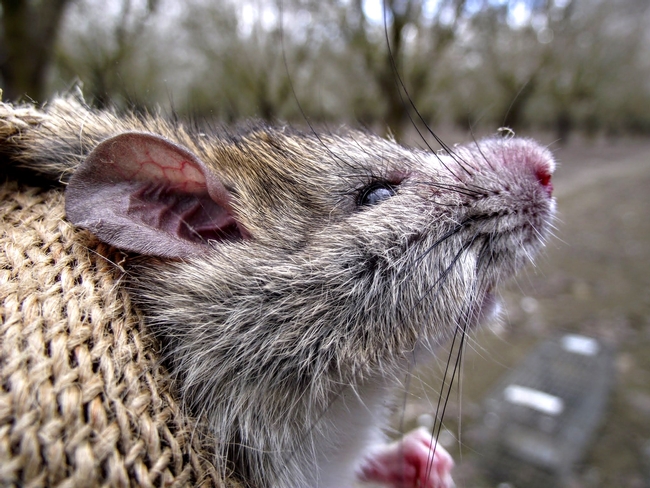
(Fresno Bee) Robert Rodriguez, March 12
Roof rats, a common problem for city dwellers, are migrating to California farms and nibbling on everything from avocados to irrigation tubing.
University of California scientists say last year's wet weather created a perfect environment for the quick-breeding rats to flourish.
…"Rodents are everywhere and they are opportunists," said Rachel Long, a University of California, cooperative extension adviser. "They move in from their surrounding urban habitats to take advantage of any food source they can find. And once that food source disappears they search for food elsewhere."
http://www.fresnobee.com/news/business/agriculture/article204696074.html
Do Backyard Chickens Need More Rules?
(KQED) Menaka Williams, March 12
…It was easy to welcome another chicken, partly because Oakland's local policies for keeping poultry aren't that restrictive. Roosters aren't allowed, and hens just have to be housed at least 20 feet from any house. That's it. No rules about the number of birds, their coops, slaughter or care. Bare-bones local laws around chickens are really common, says Catherine Brinkley, a veterinarian and urban planner at the University of California, Davis.
Brinkley says these policies tend to focus on limiting nuisances, like early morning cock-a-doodle-dos or eyesore coops — leaving a gap in codes when it comes to health and safety. "They're not at all focused on public health considerations, like [requiring] training for new owners in washing hands and selling eggs, nor do they think about if somebody is hoarding chickens or other awful things that, quite honestly, happen with animal welfare," Brinkley says.
https://www.kqed.org/bayareabites/125604/do-backyard-chickens-need-more-rules
OPINION Farm Bill must include climate change adaptation
(Redding Record Searchlight) Marty Walters, March 9
A new study published by a group of University of California researchers led by Tapan Pathak, published in the journal Agronomy, provides a whole new level of analysis in the ways that California's agriculture will change and be stressed by our changing climate, and it recommends ways to reduce some of the negative effects.
OPINION The self-inflicted economic damage to American agriculture
(The Hill) Daniel Sumner, March 9
Agriculture is so fully integrated into world markets that consumers everywhere take for granted that ripe peaches will be available to everyone, everywhere in January, while Zinfandel, Shiraz and Prosecco are universally available. Likewise farmers all over the world use tractors made in America, and tomato processors use equipment from Italy.
Study indicates that climate change will wreak havoc on California agriculture
(LA Times) Michael Hiltzak, March 9
The California we know is the breadbasket of the nation, producing more than two-thirds of the country's fruits and nuts, including almonds, pistachios, oranges, apricots, nectarines and prunes, and more than a third of its vegetables, including artichokes, broccoli, spinach and carrots. It's all valued at more than $50 billion a year.
http://www.latimes.com/business/hiltzik/la-fi-hiltzik-climate-agriculture-20180309-story.html
Precise gene technology impacts GMO debate
(Capital Press) Tim Hearden, March 8
Precise gene-editing technology is bringing the debate over genetically modified crops into a new era, researchers and experts say.
While the use of GMOs has ignited a high-pitched public debate for years, the ethical and socioeconomic debate over the newer techniques “seems to be keeping pace with the science,” observes Neil McRoberts, a University of California-Davis associate professor and plant pathologist.
http://www.capitalpress.com/SpecialSections/Seed/20180308/precise-gene-technology-impacts-gmo-debate
Trade war could spark food fight, California growers fear
(LA Times) Geoffrey Mohan, March 2
Steel and aluminum may be the intended quarry of a trade war that President Trump has said would be "good" for the U.S. economy, but the casualties of the conflict could be food, agricultural economists warn.
… No state has more at stake than California, which leads the country in agricultural revenue. Farmers and ranchers in the Golden State are twice as dependent on foreign trade as the country as a whole. World leaders also likely know that Trump enjoyed deep support in rural, agricultural areas, including much of the Central Valley, said Dan Sumner, an economist who directs the Agricultural Issues Center at UC Davis.
http://www.latimes.com/business/la-fi-trade-war-agriculture-20180302-story.html
'Real' Christmas trees support farmers and the environment
Most real Christmas trees sold in California are raised on farms, creating jobs and boosting the economies in rural areas.
That's just one reason UC Cooperative Extension advisor Lynn Wunderlich encourages the use of fresh-cut Christmas trees during the holiday season.
"This is an age-old debate," Wunderlich said. The American Christmas Tree Association says that PVC used in artificial trees is recyclable. If a household decorates with the same artificial tree for at least four years, the carbon footprint will be smaller than that of a household that purchases a real tree every year.
But the impact goes deeper. Wunderlich points out that artificial trees are mainly made in Asia. They have to travel a great distance to the U.S. compared to an American-farmed tree, eating up natural resources during transport. "Buy American," Wunderlich says.
Besides, there are the transcendent benefits of real Christmas trees. Farmed trees provide open space and wildlife habitat during the off-season, and fill the home with a natural pine scent during holidays.
Their role in sequestering carbon is aided by a production practice used by many farmers, called "stump culture."
"They use the same root system to regrow another tree, so the trees are regenerated," Wunderlich said. "Trees are replanted regularly in other farming culture. Christmas trees sequester carbon. Nearly a ton of carbon per acre of trees, depending on species and number of trees planted on the land."
While artificial trees end up landfills or energy-intense recycling plants, live trees are biodegradable. They can be naturally recycled by composting or shredded to use as mulch. Many communities offer curb-side pickup in the days after Christmas.
While farmed trees can be purchased on tree lots, home improvement stores, even grocery and drug stores, Wunderlich says a trip to a choose-and-cut tree farm is an enchanting family outing. Many Christmas tree farmers also provide food, crafts, activities and visits with Santa.
“Families can visit the farmer year after year as their children grow, so that's part of the experience,” Wunderlich said.
Resources:
The California Christmas Tree Association maintains a directory of choose-and-cut Christmas tree farms around state.
Some National Forests allow Christmas tree cutting with a permit. Read more here.
UC offers spray application training Sept. 22-23 in Davis
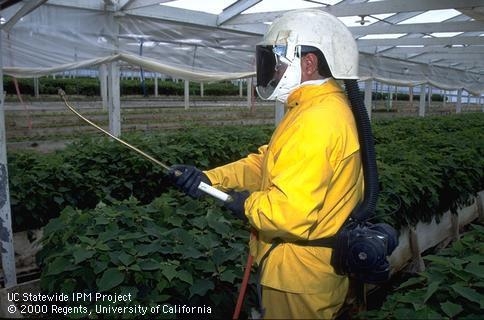
The intensive, hands-on workshop will be led by Ken Giles, professor in the Department of Biological and Agricultural Engineering at UC Davis; Franz Niederholzer, UC ANR Cooperative Extension advisor for Colusa, Sutter and Yuba counties; and Lynn Wunderlich, UC ANR Cooperative Extension advisor for the Central Sierra region.
The UC ANR instructors will train participants to identify the appropriate spray equipment components, practices and conditions necessary to deliver safe and effective agricultural pest control to a particular location, timing and crop.
The workshop will cover nozzles and atomization, the dynamics of drift and how spray droplets move, factors affecting spray deposition, hydraulic nozzle alternatives (electrostatic, air shear, etc.), measuring spray coverage, pumps, sprayer selection, air-assisted spraying and more.
Before the class, to fully prepare, registrants should view a short, online PowerPoint presentation about basic sprayer calibration. A link to the PowerPoint will be sent in the registration confirmation email. A brief quiz on the material will be given at the beginning of class on Sept. 22.
The training is set to begin at 12 noon on Sept. 22, resuming at 8 a.m. on Sept. 23 and end at 2 p.m.
Registration for the training costs $150 until Sept. 12 and $175 after Sept. 12 and can be paid online at the registration website. Onsite registration will cost $200. The organizers have applied for CDPR Continuing Education units.
To register or to get more information, visit http://ucanr.edu/sites/Spray_Application_Training.
Winegrape growers concerned about drought

Joyce spoke to a a dismayed winemaker, a worried vineyard manager and he gathered background for his four-minute story by interviewing Lynn Wunderlich, UC Cooperative Extension farm advisor for El Dorado, Amador, Calaveras and Tuolumne counties.
"There's a lot of concern out there amongst growers that I work with in the four counties in the Central Sierra," Wunderlich said. "Generally in the foothills we have a shorter depth in the soil from the surface to the bedrock, so that all impacts the available water that a grower has."
Because of the drought, Wunderlich said some growers are extending their wells or digging new wells to increase groundwater supply.
"I even had an email from a small grape grower who said he's collected rainwater this season," Wunderlich said. "So people are getting quite creative in their attempts to conserve water, knowing that we're going to have potentially a tough season."

